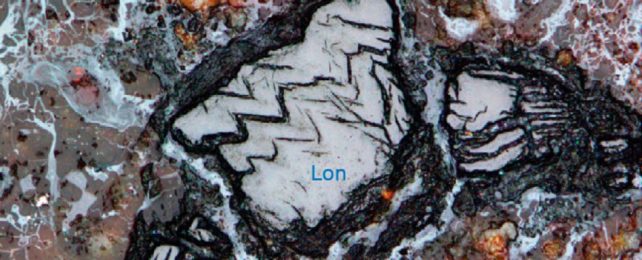Scientists think they have finally figured out why a super-hard form of diamond called lonsdaleite is found inside a rare type of meteorite. If researchers are right, the crystal's origin story is every bit as shocking as the material itself.
Unlike traditional diamonds, which are formed when graphite is squeezed slowly by the pressures deep within Earth's mantle, lonsdaleite may have formed in the chaos of a catastrophic collision in interplanetary space.
Run-of-the-mill diamonds consist of carbon atoms with all four of the available electrons linking with a neighbor in a tetrahedral pattern, making the whole structure robust enough to make the crystal one of the hardest substances on Earth.
Lonsdaleite is also a crystal made of carbon, only with a structure that perfectly preserves the hexagonal shape of graphite.
According to computer models, that structure should make the material even stiffer than traditional diamond. But proving that hypothesis is difficult.
Lonsdaleite is very rare, and the few samples that have been collected so far are much, much thinner than a human hair, making their analysis in the laboratory a challenge.
The bizarre material was first identified in a meteorite in 1967, and it has befuddled scientists pretty much ever since. In 2014, a group of researchers argued that lonsdaleite was actually not a discrete, naturally occurring material, but, rather, a conventional diamond that was simply in disorder.
In the years since, however, that hypothesis hasn't stood up to scrutiny.
While lonsdaleite has mostly been found in a rare type of stony meteorite called a ureilite, it has also been made in the lab under high temperatures, and identified on Earth in places thought to have been hit by asteroids.
Ureilites are thought to have originated in a long obliterated dwarf planet, now smeared through the Solar System in the form of small chunks of space debris.
This further supports a collision origin theory for lonsdaleite, although not all scientists are in agreement.
Using advanced electron microscopy techniques on 18 ureilite samples, an international team of researchers zoomed in on the formation of lonsdaleite like never before.
The authors say they have finally proven that lonsdaleite can form naturally and in a way that is remarkably similar to how scientists synthesize the material in the lab.
"There's strong evidence that there's a newly discovered formation process for the lonsdaleite and regular diamond, which is like a supercritical chemical vapor deposition (CVD) process that has taken place in these space rocks, probably in the dwarf planet shortly after a catastrophic collision," explains microscopist Dougal McCulloch from RMIT University in Australia.
"Chemical vapor deposition is one of the ways that people make diamonds in the lab, essentially by growing them in a specialized chamber."
The findings align with previous research that has also found signatures in diamond-filled meteorites that are consistent with low-pressure CVD processes.
But unlike some other papers, this one suggests that lonsdaleite is formed in a mildly pressurized environment of an impact between a sufficiently sized mass and a dwarf planet – not in the highly pressurized mantle of a larger planet, as is the case with traditional diamond.
Most of the meteorite samples analyzed in this latest study contained clusters of small diamonds embedded in graphite. These diamond-rich sections were neighbors to diamond-less patches, and in between, researchers often found the hexagonal-shaped structure of lonsdaleite.
According to the researchers, if the right composition of mineral is given a big enough shock, hot gas and fluid could theoretically disperse along fractures and grain boundaries, shocking the graphite into lonsdaleite's hexagonal structure. As the rock cools, these regions could then form subgrains of super-hard material.
"Nature has thus provided us with a process to try and replicate in industry," says geologist Andy Tomkins from Monash University in Australia.
"We think that lonsdaleite could be used to make tiny, ultra-hard machine parts if we can develop an industrial process that promotes replacement of pre-shaped graphite parts by lonsdaleite."
One day, it could even make for a super-rare engagement ring.
The study was published in PNAS.
